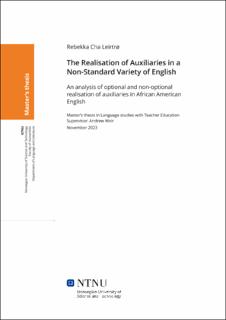| dc.contributor.advisor | Weir, Andrew | |
| dc.contributor.author | Leirtrø, Rebekka Cha | |
| dc.date.accessioned | 2024-01-11T18:19:33Z | |
| dc.date.available | 2024-01-11T18:19:33Z | |
| dc.date.issued | 2023 | |
| dc.identifier | no.ntnu:inspera:155667384:37851767 | |
| dc.identifier.uri | https://hdl.handle.net/11250/3111205 | |
| dc.description.abstract | Denne masteroppgaven søker å forstå grammatikken bak utelatte hjelpeverb i afrikansk amerikansk engelsk (AAE) ved å stille disse spørsmålene: Er hjelpeverb i AAE til stede på et av representasjonsnivåene? Om de er det, hvile regler og prinsipper styrer dette? Omfanget til oppgaven blir begrenset ved å kun undersøke to ulike setningstyper: enkle deklarative setning, slik som «she dancing», og setninger som inneholder aspektuelle markører, slik som «she BIN dancing». Realiseringen og ikke-realiseringen av hjelpeverb i disse setningene er enten valgfritt (enkle deklarative setning), eller ikke (setninger som inneholder aspektuelle markører). Den sistnevnte setningstypen er analysert syntaktisk, hvor det blir argumentert for at realiseringen av hjelpeverbene kan minne om «do-support» i standard engelsk (SE), som viser at disse hjelpeverbene ikke er slettet. Når de blir brukt i setninger som inneholder aspektuelle markører, er de satt inn og ikke tvunget til overflaten. Videre er enkle deklarative setninger analysert fonologisk ved å bruke et optimalitet-teoretisk rammeverk. Dette rammeverket forklarer at svake stavelser blir slettet, som leder til uteblivelsen av hjelpeverb. I tillegg fanger det valgmulighetene angående realiseringen av hjelpeverbene, som viser den lingvistiske variasjon innad AAE. | |
| dc.description.abstract | This thesis seeks to understand the grammar of omitted auxiliaries in African American English (AAE) by asking the questions: Are auxiliaries in AAE present at any level of representation? Then, if they are, what rules or principles govern it? The scope is narrowed by only considering two types of sentences, plain declaratives, such as “she dancing”, and sentences containing aspectual markers, such as “she BIN dancing”. The realisation and non-realisation of the auxiliaries in these sentences are shown to be either optional (in plain declaratives) or non-optional (in sentences containing aspectual markers). The latter sentence type is analysed syntactically, where it is argued that the realisation of auxiliaries can be reminiscent of standard English (SE) do-support, showing that the auxiliaries are not deleted. When they appear in sentences containing aspectual markers, they are inserted rather than being forced to the surface. Furthermore, the plain declaratives are analysed phonologically, utilising an Optimality-Theoretic framework. This framework provides the explanation that weak syllables are deleted, leading to the medial auxiliaries to be omitted. It also captures the optionality of realisation of auxiliaries, showing the linguistic variation within AAE. | |
| dc.language | eng | |
| dc.publisher | NTNU | |
| dc.title | The Realisation of Auxiliaries in a Non-Standard Variety of English: An analysis of the optional and non-optional realisation of auxiliaries in African American English | |
| dc.type | Master thesis | |
